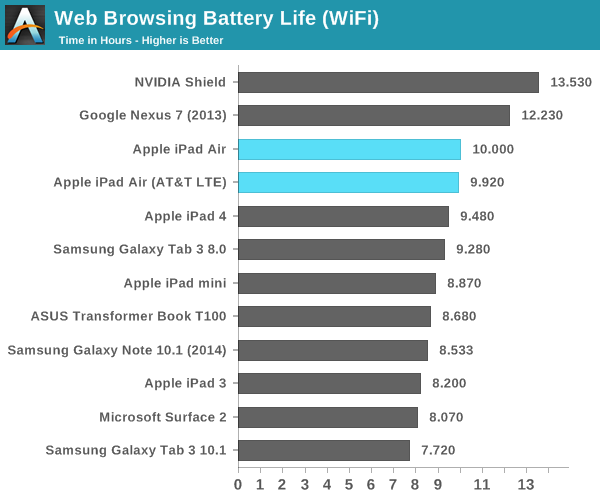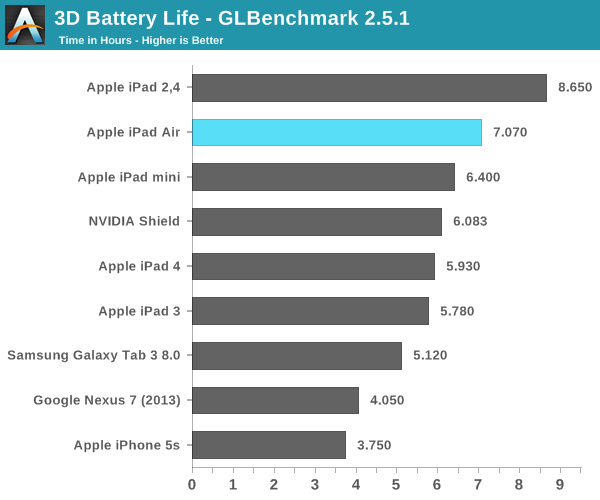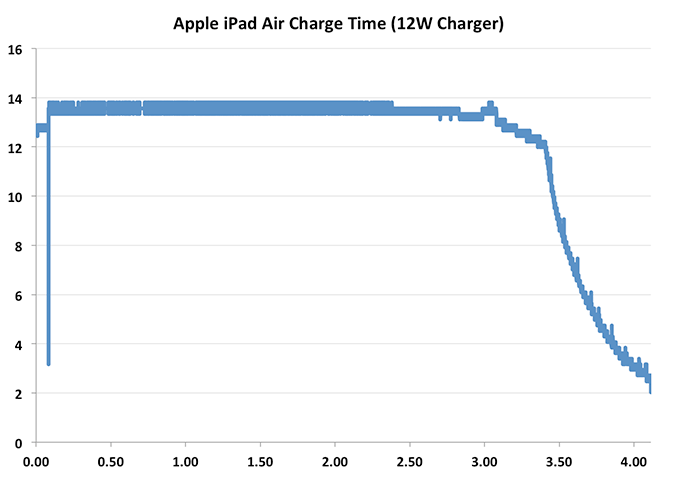The iPad Air Review
by Anand Lal Shimpi on October 29, 2013 9:00 PM ESTBattery Life
With the iPad Air Apple moved to a 32.4Wh battery, a significant decrease from the 42.5Wh unit in the 3rd and 4th generation iPads. The smaller battery doesn’t come with a change to Apple’s claim of 10 hours of battery life, which implies a reduction in overall platform power. I confirmed a substantial reduction in platform power in my crude measurements earlier in the article. Although it’s possible for the iPad Air to draw substantially more power than the iPad 4, our earlier power data seems to imply that it’s unlikely given the same exact workload. Our battery life tests agree.
We'll start with our 2013 smartphone/tablet web browsing battery life test. As always all displays are calibrated to 200 nits. The workload itself is hidden from OEMs to avoid any intentional gaming, but I've described it at a high level here.

Our web browsing workload came in at exactly 10 hours of continuous usage - an improvement compared to the iPad 4. Battery life on LTE was good as well, consistently delivering just under 10 hours of usage. The fact that both LTE and WiFi tests deliver similar results tells me that we may be bottlenecked by some other component in the system (perhaps display?).
I've been running the same video playback test for a while now, although we're quickly approaching a point where I'll need to move to a higher bitrate 1080p test. Here I'm playing a 4Mbps H.264 High Profile 720p rip I made of the Harry Potter 8 Blu-ray. The full movie plays through and is looped until the battery dies. Once again, the displays are calibrated to 200 nits:

Video playback battery life also improves slightly compared to the iPad 4. Apple’s battery life claims aren’t usually based around video playback, so exceeding their 10 hour suggestion here shouldn’t come as a shock. Apple’s video decode power has always been extremely low.
Our final cross-platform battery life test is based on Kishonti's Egypt HD test. Here we have a loop of the Egypt HD benchmark, capped to 30 fps, running on all of the devices with their screens calibrated to 200 nits.

Our 3D battery life rundown test shows a substantial improvement in battery life over the iPad 4. IMG’s PowerVR G6430, running a moderate workload, can do so more efficiently than any of the previous generation GPUs in Apple’s SoCs. Much like the A7’s CPU cores however, there’s a wider dynamic range of power consumption with the G6430. Running at max performance I would expect to see greater GPU power consumption. The question then becomes what’s more likely? Since the majority of iOS games don’t target the A7 (and instead shoot for lower end hardware), I would expect you to see better battery life even while gaming on the iPad Air vs the iPad 3/4.
Charge Time
The iPad Air comes with the same 12W USB charger and Lightning cable that we first saw with the iPad 4. Having to only charge a 32.5W battery means that charge times are lower compared to the iPad 3 and 4:

A full charge takes a little over 4 hours to complete. The adapter delivers as much as 12W to the iPad, drawing a maximum of 13.5W at the wall. I still think the sweet spot is somewhere closer to 2.5 hours but that’s another balancing game that must be played between charge time and maintaining battery health. It’s still so much better than the ~6 hours of charge time for the iPad 3 and 5.69 hours for the iPad 4.











444 Comments
View All Comments
rituraj - Wednesday, October 30, 2013 - link
What?dugbug - Wednesday, October 30, 2013 - link
astroturfKevin G - Wednesday, October 30, 2013 - link
Whoa, 6 issue architecture in a phone/tablet? Apple wasn't kidding when they said 'desktop class' performance. I'm wondering what low level power management voodoo they have going to pull that off.The flip side is that if Apple wanted to build a real desktop/server class chip, they look like they could pull it off and be competitive with Intel. Disable Turbo and throttle down a Haswell to 1.4 Ghz and do a performance and performance per watt comparison. I fathom that Intel still leads but Apple's A7 design will be seriously competitive.
I am in agreement that Apple should have moved to 2 GB of memory here. One could argue the merits of keeping with 2 GB on the phone but in the age of retina displays on tablets, it'll seem constrained over the long term. This would have been an ideal way to distinguish the iPad's hardware from the iPhone in terms of hardware features/performance. Ditto for not going with a 128 bit wide memory interface. Hell, it would have made sense for Apple to build the die with a 128 bit wide bus but only use the full width in the iPad.
ananduser - Wednesday, October 30, 2013 - link
Intel's Atom runs a full size desktop OS. That's more of a load on it than simple mobile software like ios. The best ARM can muster is not even close to Intel.Arbee - Wednesday, October 30, 2013 - link
iOS is OS X (true BSD UNIX) with a different top level GUI. Similarly, Android is creeping towards feature parity with desktop Linux, although they have farther to go on audio and MIDI, and Windows Phone runs the real NT kernel. They're all a lot less different from a "full size desktop OS" than you seem to think.Kevin G - Wednesday, October 30, 2013 - link
There is an Android port for x86 which would put Atom SoC's like Baytrail on equal footing.The thing is that the Cyclone core is wider than even Haswell: 6 vs. 4. (For reference Silvermont is 2 issue.) Haswell likely has a higher throughput of instructions considering its x86 ISA (more load/stores for example) and different balance of execution units.
errorr - Wednesday, October 30, 2013 - link
It is reportedly a very buggy port and DALVIK is broken which means it is useless. Plus it is not 64bit enabled yet which hurts bay trail.Wilco1 - Thursday, October 31, 2013 - link
Cyclone may well be 6-issue, but that's not unusual: Cortex-A15 is 8-issue. This is a design decision based on whether to use a single big issue queue or multiple separate issue queues (there are advantages/disadvantages either way). However it seems likely it is 4-way decode, just like Haswell. And the decode rate determines the sustained performance.KPOM - Wednesday, October 30, 2013 - link
Perhaps battery life came into play. Remember, Apple doesn't add specs for the sake of winning spec wars. They may also be trying to discourage developers from simply writing RAM-hungry apps that will leave the iPhone 5c and iPad 2 behind. 64-bit is supposed to be a smooth transition.Plus, I'm sure they're looking to keep some reasons to upgrade to an "iPad Air 2" or "iPad Pro" next year. 2GB would be nice, but I don't think 1GB will be a problem for most users.
YuLeven - Wednesday, October 30, 2013 - link
As we're kindly reminded in every other tablet's review about things like 'this tablet is good, but it don't have the number of tablet optimized that the iPad has', I would kindly like to remind you a couple of small... well, shortcomings of the iPad. Ups, I said that.The iPad is good, but it can't open two apps at once.
The iPad screen is great and sharp, but it's 4:3 aspect ratio is far worse than 16:9 for video watching, specially TV (Netflix, Hulu) shows.
The iPad is bright, but its far more reflexive than Surface's.
The iPad is good, but you don't have USB mass storage mode.
The iPad is good, but you can't expand your memory.
The iPad is good, but you can't use your external HD, pendrive, printer, mouse and other hardware stuff via USB port.
The iPad is good, but office experience on it falls short of the one on Windows RT.
The iPad is good, but you can't have a browser running on the background, for exemple for listening to some youtube music video while you have two other apps running on the front end.
The iPad gestures are good, but multitasking by a simple swype from the left feels better than having to using four finger at once.
The iPad is light and it's ok to use the cover as a stand, but it feels less confortable than having a real, sturdy quickstand.
The iPad thousands of apps are great, but some of them are worse than using the actual website: Facebook and Pandora, for example.
The iPad is good, but its experience using a remote desktop is worse than on other tablets.
Well, the list goes on.
Not that the iPad is a bad tablet, quite the opposite actually. But as reviews usually like to remind us of things that Android/Windows RT tablets can't do - and the iPad always can, as a matter of fact -, I wanted to recall some things that Android/Windows RT do superbly - and the iPad don't, as a matter of fact -.